With the massive amount of email checking, texting, mobile gaming and internet surfing everyone does, a reliable, portable charger has become essential to avoid the inevitable dead battery.
Based on amount of usage we were able to get, weight, size and overall functionality, we tested a variety of chargers by mixing around charge times with an iPhone 6, iPhone 5, iPhone 4, Samsung Galaxy S4 and iPad 4 in different situations to create a list of the best portable chargers - though most of the external batteries are compatible with an assortment of phones, tablets, cameras and handheld gaming devices.
We've also added a few chargers towards the end of the list that are more suitable for a day out rather than a long trip away, just in case you're just looking for a super light, quick backup charge.
Prices are also always dropping and new portable chargers keep getting released, so keep checking back to see what else we've updated and added!
Additional testing by Alex Williams.
Jackery Giant

Price: $39.95, previously $44.95
The bright orange (or silver option) Jackery Giant lives up to its name as a hefty charger weighing in at 10.4 ounces (the same as the IOGEAR GearPower) but also because it's a heavyweight champ in other ways as well.
For the large 10,400mAh capacity, it's one of the cheapest chargers you can get. The Giant also travels well and can be taken on outdoor adventures thanks to its ability to hold a charge for a long time, though you'll need to charge the battery itself a whole night (about 10 hours) for a full charge beforehand.
The battery also packs a little LED flashlight which can be activated by pressing the power button twice (to avoid accidental usage), and is pretty handy if you're camping or need to find something in a flash.
The Jackery Giant did a good job charging our S4 and iPad 4 simultaneously - 10% to 95% and 47% to 96% in about two and a half hours, respectively. What's more, it even had enough juice to charge up the iPhone 5 up, with two light bars remaining.
If you're only planning to get the Giant as an occasional backup, it will hold a charge for up to six months.
Lumsing Power Bank (LUM 008-01)

Price: $25
With an unbeatable price tag, a high-powered 10,400mAh battery and moderate weight of 8.35 ounces, the larger capacity Lumsing Power Bank (LUM 008-01) is debatably one of the best portable chargers on the market.
The sleek white eggshell color (which also comes in black and champagne gold) and ergonomic design is thick but smooth to the touch, with edges accented in a silvery finish. On its side, the device has two USB ports at 1A and 2.1A, and one Micro USB 5V input used to power up the device itself. Press the oval button on the LUM 008-01's side, and four blue LED lights illuminate, each indicating 25% battery life.
We put the LUM 008-01 to the test by dual charging two different smartphones at the same time: our iPhone 4 at 70%, and our HTC One (M8) at 60% with the Spotify app running in the background.
The LUM 008-01 used 25% of its total charge, powering both phones to 100% with an average of two minutes and thirty seconds for each 1% recharge. When testing alone with our iPhone 4 at zero percent on standby, the LUM 008-01 used about 15 to 20% of its total energy and took an average of 51.5 seconds per one percent recharge.
If Lumsing has anything to be proud about, it's this.
Lumsing Power Bank (PBJ-6200)
Price: $13
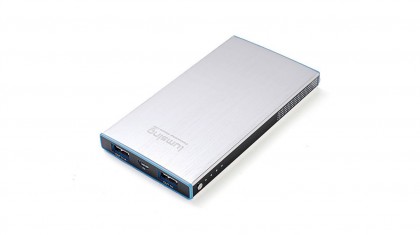
Possibly one of the most affordable portable charger on the market, this Lumsing Power Bank is almost the size of an iPhone 6 in length, and weighs in at 6.49 ounces. It's small enough to carry around in your pocket, and can charge two devices with its two USB ports at 1A and 2.1A.
The 6,000mAh charger comes outfitted with a brushed silver aluminum shell with blue outlining on the top and bottom portions (it also comes in black with an orange outlining.) Like the LUM 008-01, pressing the side button of the charger illuminates four small blue LED lights each representing units of 25% power. On closer inspection, the PBJ-6200's body seems to be a little bloated in the middle.
The PBJ-6200 roughly used 30% to 40% of its energy and took an hour to fully charge our iPhone 6. We fully charged our iPhone 6 again when it drained to 30%; the PBJ-6200 then showed two lights left. Finally, we used up the PBJ-6200's remaining power by giving our iPad mini a 52% charge.
Despite taking about five hours to charge at 100%, the PBJ-6200 is incredibly inexpensive with decent charging capabilities.
Juno Power Hue Plus
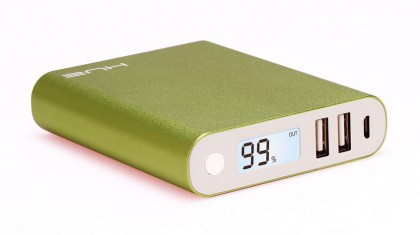
Price: $59.99, previously $99.99
The 9900mAH Hue Plus from Juno Power is a bit on the heavier side at 9 ounces like the other larger capacity chargers but it's well worth shouldering the weight.
The Plus has a nice little LCD screen that tells you the declining charge amount which comes in handy if the usual indicator lights just won't do it for you.
There are also two USB ports (with one being 2.1A) that allow for dual device charging. On a road trip to LA, the Plus was more than capable of charging two iPhone 5's - where one phone was used heavily and one used minimally. The charger ended out the nine hour trip with 19% left and took the night to recharge, which brings us to the next point.
Oddly, the Hue Plus makes whirring noises when recharging - though it's best to keep in mind that it may be specific to the test product. Another note about recharging the portable: you may want to keep it away from your bedside table as the LCD screen stays lit up.
The Hue Plus also appropriately comes in five different hues.
IOGEAR GearPower Ultra Capacity Mobile Power Station
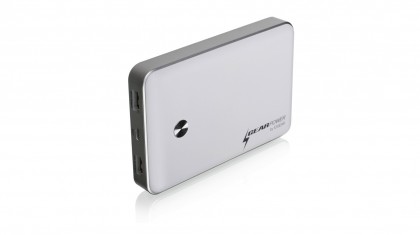
Price: $45.96, previously $79.95
IOGEAR's GearPower Ultra Capacity charger is a great portable battery. Two USB ports at 1A and 2.1A allow for multi-device charging and at 11,000mAh, you can easily charge a phone and tablet respectively.
Though it's not very pocket friendly at 10.4 ounces and a tad bulkier than an iPhone and Galaxy S4, this is still an adept portable and great for traveling long distances in the car or plane.
In fact, we took the battery to a two-day music festival and it had no issues charging two iPhone 5's that were around 10% each, during the 48-hour span of Instagramming, phone calls, etc. After a 55 minute charge at the end of the first day, each phone was fully charged with the GearPower lights at three bars indicating that it was still able to keep going for a few more days - depending on what needed to be charged next of course.
The price point may seem high but the GearPower can be bought at much cheaper prices making it a fantastic deal for long trips away from outlets.
ZAGGsparq 6000

Price: $55, previously $99.99
The ZAGGsparq 6000 charger is still a decent backup, despite a few caveats.
Its 2.1A USB outlets got the job done efficiently with two smartphones and it was able to hold a charge the next two days.
Unfortunately, the 6000mAh isn't too great with tablets and was only able to charge an iPad from 25% up to 60% before dying down to one LED light of juice left.
Not only is the ZAGGsparq small and light, but it's also wide, making it awkward to carry if using a purse or small bag - though if in a backpack, you'll hardly feel it.
The built-in prongs make it easy to charge and means there's one less cord to lose, which is actually really quite nice, and its on/off switch is accident-proof, meaning you won't randomly turn it on and waste your charge.
Mophie Juice Pack Powerstation Duo
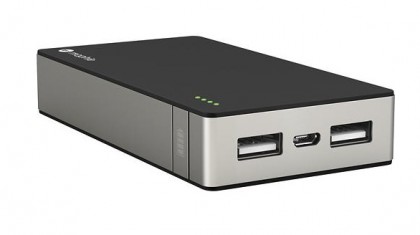
Price: $99.95
Easily one of the pricier chargers, the Juice Pack Powerstation Duo from Mophie is still a nice little 6000mAh portable. At 11.99 ounces it actually feels lighter than its battery counterparts despite weighing the most. Because of this, it makes for a great travel companion as you can hardly feel it in your bag.
Two 2.1A USB ports allow for quick dual charging of tablets and phones, which it was quite capable of during our trips to and from the office; 0 percent battery on the iPhone and Galaxy S4 were raised to around 88% - 95% each after an hour, and it still had two lights left.
The Mophie also stayed light as a feather in our backpack though its smooth exterior did collect a lot of lint meaning it's probably a good idea to use the little pouch the battery comes with.
The biggest downside to the Mophie Powerstation Duo is its price. If you can afford the Duo, it'll serve you well, but if you want to go cheaper, Mophie has a nice little selection and from our experience with the high cost charger, it seems like the low cost options aren't too bad either.
Anker Astro 3E 10000mAh
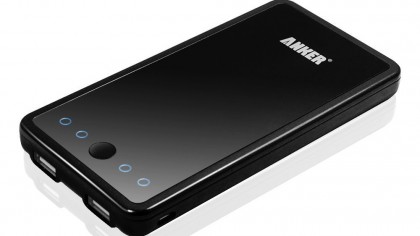
Price: $25.99, previously $39.99
It seems like it's go big or go home for the Anker Astro 3E. Like the Jackery Giant, the Anker Astro 3E is a beast of a charger and won't easily fit into your coat pocket.
Though it is a bit thinner than the other batteries on this list, it's still longer than the length of your average smartphone.
The Astro boasts the ability to hold over six charges for most smartphones - we were able to get about four with two smartphones simultaneously thanks to its two USB ports, and a third of a charge for our tablet by itself over four days before the Astro died, which isn't too shabby for 10000mAh.
Keep in mind, since it's a bit larger, it's not really a small bag type of portable - but a long trip will definitely benefit from the Astro, and it still won't take up too much room inside your bag with all your other tech devices.
Eton BoostBloc 6600
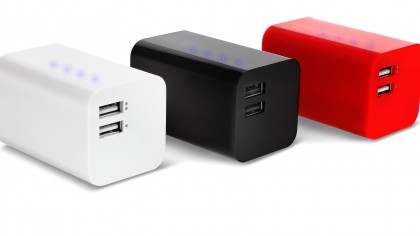
Price: $36-$65, previously $99.99
The high-priced Eton BoostBloc 6600 is a modest charger that surprisingly holds 6600mAh for how small it is.
Its lightweight 6.5 ounces means its purse friendly and maybe even pocket friendly (for jackets at least) if you don't mind carrying something else besides your phone around, that has a bulky form factor.
It has two USB ports, 2.1A and 1A, and no on/off button, and you can shake the device for the indicator lights to pop on and tell you how much juice is left.
The BoostBloc 6600 holds charges for quite awhile and was able to charge up our iPhone 5 and Samsung Galaxy S4 from around 20% - 25% to 100% twice on one charge, and iPad 4 about halfway before giving out.
You'll probably have to charge the BoostBloc often if you plan on using it on tablets and phones simultaneously, but the portable charges up quickly (and gets pretty hot) - this shouldn't be too much of an issue especially if you plan on taking it with you everywhere.
Powerocks Rose Stone
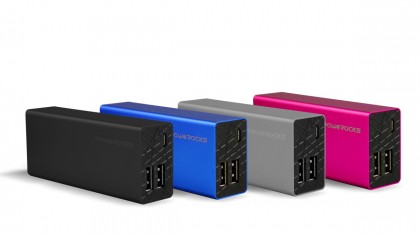
Price: $39.50-$42.50, previously $69.99
With 6000mAh, the Powerocks Rose Stone charges up around the same as the BoostBloc 6600 and boasts the same lightweight portability. However, it's longer than the BoostBloc, so it will probably be best off in a bag.
Going along with the geological theme, the indicator lights are little rock-like formations next to a camouflaged power button, making this charger quite different and fun (as much as a battery can be?)
There are also two USB ports but each only gives off 1A, so charging will be a bit slower.
But that doesn't mean the Rose Stone will leave you hanging out to dry - the battery was able to give us great juice charges on our smartphones three times on one charge. The iPad 4 wasn't as lucky though and had to charge on the next round and only from 15% to 65%, probably due to the output volume.
So as a portable, the Rose Stone is best for smartphones and does quite well, but you're better off with a Powerocks charger with a larger capacity if you're interested in this brand and design.
Outdoor Tech's Kodiak 6000
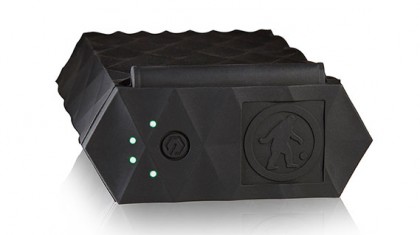
Price: $49.95
With a fitting name, the Kodiak 6000 by Outdoor Tech is a silicone wrapped rubbery and ruggedized USB power bank that you wont feel guilty about roughhousing with.
Though bulky and weighing 9.4 ounces, the Kodiak is a unique portable charger, advertising itself as dustproof, shockproof and waterproof. The device is covered with a hinged silicon lid, promising IPX7 waterproofing when closed, and IPX5 when opened - it's submersible in water up to three feet for 30 minutes.
Under the Kodiak's lid on top is one USB output at 2.1A, which is adjacent to an embedded power button. Press the power button once without using the ports, and the Kodiak illuminates four green LED lights each representing a 25% charge.
With a 6,000mAh capacity, the Kodiak took an average of three minutes and 59 seconds for each one percent charge for our iPad mini, and was able to supply it with one and half full charges (150%) before running out of juice. We also fully charged our iPhone 4 in two hours and twenty minutes, using only 20% of the Kodiak's power.
Despite the price and singular USB port, the Kodiak makes up for its durability to survive the great outdoors as well as provide about five full charges for your smartphone.
Dark Energy Reservoir

Price: $99, previously $129
The Dark Energy Reservoir, an 8,000mAh battery pack, has USB ports are used for charging your devices, and the microUSB port between them is used for charging the device itself.
Once your devices are plugged in, you just press the power button on the Dark Energy Reservoir and they'll start charging. If there aren't any devices connected and you press the power button, the light indicators will glow to show you how much juice is left in the thing. There are three dot lights, each dot represents about 33% of battery life.
It's quite expensive but worth it if you have the dough.
Belkin PowerPack 4000

Price: $49.95, previously $99.99
A well known brand for supplying electronic accessories, Belkin's largest capacity portable charger surprisingly only holds 4000mAh.
The PowerPack 4000 is still able to do a fairly decent job though, and is definitely one of the most lightweight and convenient batteries at 4.6 ounces. In fact, even though the battery is pretty wide, there were times it was hard to find in our bag since it's still remains so compact.
We were able to charge our smartphones up completely from about 10% each, twice in two days before needed about three hours for the PowerPack to recharge. It was also able to charge up the iPad a little over halfway.
The PowerPack's main issue is the price point: For Belkin's current price (though you can definitely get it a little cheaper by shopping around), the capacity should at least be bigger. But we suppose transportability comes at a price.
RAVPower KnightRider 14000mAh
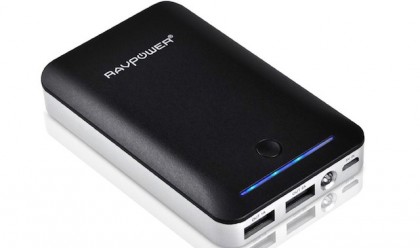
Price: $29.99, previously $42.99
The RAVPower KnightRider has massive capacity and massive weight, too - coming in at 10.4 ounces.
The Knightrider was able to charge our Samsung Galaxy S4 and iPhone 5 completely in about an hour and a half using the two USB 2A and 1A ports.
It also was able to power our iPad during an hour-long train ride providing ample time to use the tablet, and charge it afterwards up to 87% before giving out.
The battery is a pretty powerful device and like the Jackery Giant, comes with a useful flashlight which could serve as a great backup if there's an outage or if you need an extra light on hand in the dark.
It's also fantastically priced for a large capacity battery that's been really useful for commuting and will definitely do well on long trips away.
Hue Kard

Price: $34.99, previously $39.99
Think thin and light when it comes to the 4.4 ounces Juno Power Hue Kard. At 7.5mm, it's the ultimate portable phone charger. If you're already comfortable with having a smartphone sticking out of your pocket, then the Hue Kard will feel like nothing.
The Kard is also an efficient little thing, and was able to charge a near dead (four percent) iPhone 5 at a rate of a percent and a half per minute. It was also able to charge up the S4 a little over half way after fully loading up the iPhone.
A neat feature of this sleek portable charger is the on/off switch - rather than a physical button, the Kard boasts a nifty touch "button" which shows the battery's indicator lights, and starts the charging process.
The back of the Hue Kard also can serve as a mirror much like the older gen iPods - but like the older iPods, may end up a bit scratched up from use. Still, it may be useful while it lasts and at least the Kard will remain a handy portable.
id America L.E.D. (Light Energy Dock)
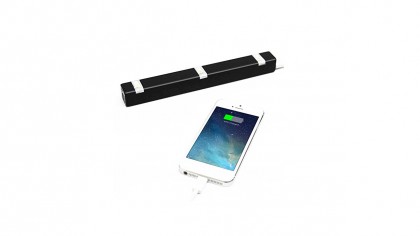
Price: $79.99
Standing for Light Energy Dock, the id America L.E.D. is a 5,200 mAh portable charger that doubles as a flashlight for when you're on the go.
The charger weighs 5.4 ounces and is equipped with high-output, low-consumption L.E.D. lights with three different brightness settings all controlled by the tap of your finger. A little circular charging dock is included which props the L.E.D. straight up.
The L.E.D. is quite useful as a light when you're reading a book in your bed at night. The built-in magnets were a nice touch in mounting on the metal lining of our desk, perfect for charging devices within reach.
There is no way of knowing how much battery life is left in the L.E.D. beyond just directly charging the device itself from an outlet. You'll know when the L.E.D. is fully charged once the slit LED light at the end of the device transitions from red to blue.
The L.E.D. quickly charged our iPhone 6 at an average of 53.7 seconds for every one percent recharge. When solely testing with our iPhone 6 alone, the L.E.D. gave back a total of 303 percent battery life - about three full charges.
Unfortunately, the steep price, lack of power indication, and cumbersome 8-inches (20.32 cm) is damaging when compared to other portable chargers.
Apelpi - Opso Plus
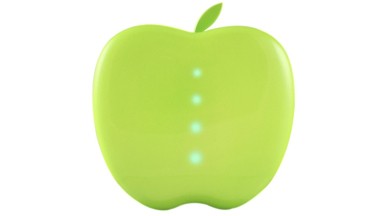
Price: $25.95, previously $49.99
Boasting one of the most unique designs, Apelpi's MFi Apple certified Opso Plus charger is a fun little portable. But don't let its pretty appearance fool you - this little apple's got a powerful bite.
At 6400mAh, the Opso Plus can charge your phone quite nicely on the go and at 5.6 ounces, it fits great in a bag - however, there is only one 1A USB port meaning it's a bit slower, and it can't fully charge a tablet. According to the company, Apple would only allow one port for MFi certification, thus sacrifices had to be made.
We took it with us to charge our Samsung Galaxy S4 battery on a 50 minute train ride, and it went from seven percent to 100% with two LED lights left allowing for at least two more charges the next day.
Additionally, though the power button is an ingenious little stem on top of the Opso, there were moments where it seemed a bit precarious sticking it in a bag for fear of breaking the stem off.
Despite this, if you need a moderately priced, nicely designed portable charger then consider Apelpi - an Opso a day will keep your phone's dead battery away.
Jackery Mini

Price: $19.95, previously $24.95
The Jackery Mini is the counterpart to the Jackery Giant and works just as great for those moments where you don't want to lug the monster around.
It will fit nicely anywhere and works well with both the iPhone and S4, however it's not a good option for tablets since it's only 1A and 2600mAh.
We were able to get two charges for each smartphone on one full-up Mini, which is quite good for the little portable. Because it's smaller, the Mini is able to recharge must faster too.
The power button may be accidentally pressed a lot (which was the case with us) so be wary of running your battery, but aside from that, the Jackery Mini is a really compact charger for when you're on the go.
Powerocks Magicstick
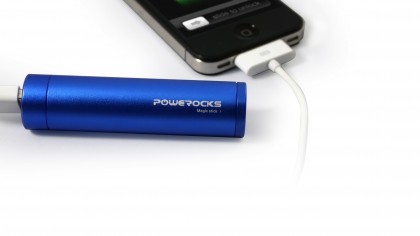
Price: $18, previously $49.99
Similar to the Jackery Mini, the Powerocks Magicstick is about the same length and width but rounded.
The Magicstick also has a slightly larger capacity at 2800mAh so we were able to get two and a little over a half charge for each smartphone.
Like the Mini, the Magicstick recharges quickly so you don't have to wait all night for a portable battery.
It's a little heavier as well but definitely not enough to be noticeable. The power button on this works like a small flashlight - you press one end which lights up letting you know if its charged up, with different colors telling you how much juice it has.
RAVPower RP-WD01 Wireless WiFi-Disk

Price: $36.99, previously $44.99
Basically, the traveling person's dream portable, this guy can do it all.
Though not as physically small as the other tiny chargers, this 3000mAh RAVPower made the list for being able to read SD cards and turn into a Wi-Fi hotspot making it a powerful compact combination when you're in need of more than one device.
It's also thin and light as a feather so you'll hardly feel it, and it won't take up room in your bag.
The charger works great and was able to fully charge a low battery S4 in one go. However, it definitely needs to be recharged often so it's probably best to use it intermittently while using the other features.
The card reader and Wi-Fi hotspot also worked quite well, and were able to power on and connect to our smartphones without too much hassle.









